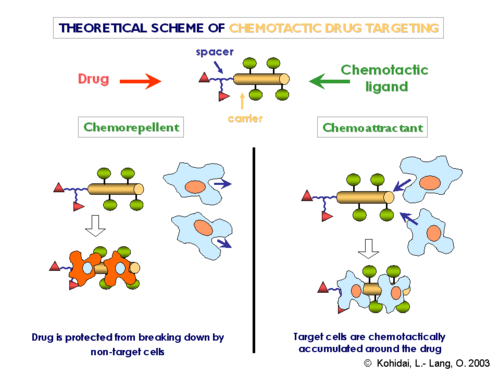Targeted drug delivery is one of many ways researchers seek to improve drug delivery systems' overall efficacy, safety, and delivery. Within this medical field is a special reversal form of drug delivery called chemotactic drug targeting.[1][2] By using chemical agents to help guide a drug carrier to a specific location within the body, this innovative approach seeks to improve precision and control during the drug delivery process, decrease the risk of toxicity, and potentially lower the required medical dosage needed.[2][3][4][5] The general components of the conjugates are designed as follows: (i) carrier – regularly possessing promoter effect also on internalization into the cell; (ii) chemotactically active ligands acting on the target cells; (iii) drug to be delivered in a selective way and (iv) spacer sequence which joins drug molecule to the carrier and due to it enzyme labile moiety makes possible the intracellular compartment specific release of the drug. Careful selection of chemotactic component of the ligand not only the chemoattractant character could be expended, however, chemorepellent ligands are also valuable as they are useful to keep away cell populations degrading the conjugate containing the drug. In a larger sense, chemotactic drug-targeting has the potential to improve cancer, inflammation, and arthritis treatment by taking advantage of the difference in environment between the target site and its surroundings.[6][7][8] Therefore, this Wikipedia article aims to provide a brief overview of chemotactic drug targeting, the principles behind the approach, possible limitations and advantages, and its application to cancer and inflammation.

- ^ Cite error: The named reference
:8was invoked but never defined (see the help page). - ^ a b Khodarahmian, Kobra; Ghiasvand, Alireza (25 January 2022). "Mimic Nature Using Chemotaxis of Ionic Liquid Microdroplets for Drug Delivery Purposes". Molecules. 27 (3): 786. doi:10.3390/molecules27030786. ISSN 1420-3049. PMC 8839142. PMID 35164048.
- ^ Lagzi, István (1 August 2013). "Chemical robotics — chemotactic drug carriers". Open Medicine. 8 (4): 377–382. doi:10.2478/s11536-012-0130-9. ISSN 2391-5463. S2CID 84150518.
- ^ Nguyen, Hung V.; Faivre, Vincent (June 2020). "Targeted drug delivery therapies inspired by natural taxes". Journal of Controlled Release. 322: 439–456. doi:10.1016/j.jconrel.2020.04.005. PMID 32259545. S2CID 215411200.
- ^ Láng, O.; Török, K.; Mező, G.; Hudecz F.; Kőhidai, L. (2003). Chemotactic conjugates New Aspects in Drug-Targeting. p. 118.
{{cite book}}:|work=ignored (help) - ^ Roussos, Evanthia T.; Condeelis, John S.; Patsialou, Antonia (August 2011). "Chemotaxis in cancer". Nature Reviews Cancer. 11 (8): 573–587. doi:10.1038/nrc3078. ISSN 1474-175X. PMC 4030706. PMID 21779009.
- ^ Li, Ting; Liu, Zhiyong; Hu, Jinglei; Chen, Lin; Chen, Tiantian; Tang, Qianqian; Yu, Bixia; Zhao, Bo; Mao, Chun; Wan, Mimi (November 2022). "A Universal Chemotactic Targeted Delivery Strategy for Inflammatory Diseases". Advanced Materials. 34 (47): 2206654. doi:10.1002/adma.202206654. ISSN 0935-9648. PMID 36122571. S2CID 252382827.
- ^ Damsker, Jesse M.; Okwumabua, Ifeanyi; Pushkarsky, Tatiana; Arora, Kamalpreet; Bukrinsky, Michael I.; Constant, Stephanie L. (January 2009). "Targeting the chemotactic function of CD147 reduces collagen-induced arthritis". Immunology. 126 (1): 55–62. doi:10.1111/j.1365-2567.2008.02877.x. PMC 2632695. PMID 18557953.